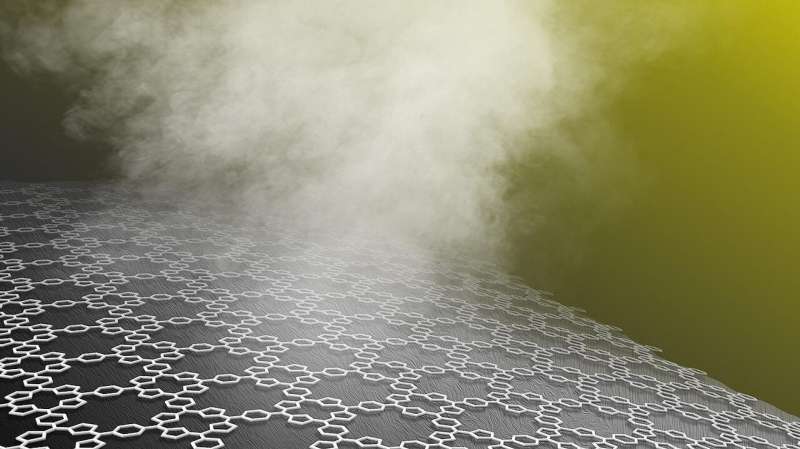In a new study, UChicago and Argonne scientists help pioneer a new method of solar steam generation. Credit: Advanced Materials Interfaces
As the global population grows, fresh water supplies are more precious than ever. While scientists and engineers know how to purify water, making those methods sustainable and energy efficient is another question.
One promising approach is solar-driven distillation, or solar steam generation, which can help us get fresh water from wastewater or seawater. Researchers have used this method to successfully distill small batches of purified water, but they are still searching for a way to do this on a large scale.
Researchers at the University of Chicago's Pritzker School of Molecular Engineering and UChicago-affiliated Argonne National Laboratory were part of a team that developed a pioneering new method of solar steam generation that could help bring this technology into the real world. The materials can be grown on top of wood, fabric or sponges in an easy, one-step process, and show promise for large-scale manufacturing.
"Solar steam generation techniques are still mostly focused on lab use now," said Zijing Xia, a graduate student at Pritzker Molecular Engineering and lead author of the research. "We want to find an easy way to fabricate solar steam generators at relatively low cost."
The results of their innovative work were recently published in the journal Advanced Materials Interfaces.
In the search for solar steam systems, researchers have already tried various materials which convert light to heat, such as carbon materials, plasmonic metals and semiconductors. But many of these options have relatively low efficiency, among other challenges, and so the search continues for a truly transformative method.
A high-performance solar steam generator will ideally combine several characteristics. It should be buoyant on water, be able to absorb a broad spectrum of light, convert light to heat efficiently and be able to transfer that heat to water. Unfortunately, many previously studied methods lack the porous structure needed to facilitate the heat transfer to water.
"Most existing methods cannot be easily engineered to produce steam-generating devices with both arbitrary control over the shape and high photothermal efficiency," Xia said.
What sets Xia's method apart is the use of a porphyrin covalent organic framework, or POF. A newly discovered class of materials, POFs can grow uniformly on the surface of a variety of materials with different levels of porosity, and they show high performance for water evaporation. POFs also have unique light-harvesting characteristics beneficial for new applications.
In the lab, POFs successfully grew on the inner and outer surfaces of every tested material. And every template showed favorable photothermal properties, indicating that POF-based materials are promising candidates for solar steam generation. The POF membrane was able to capture more than 95 percent of light across the majority of the spectrum of sunlight.
The most promising result of the research, Xia said, was the POFs' ability to grow at the surface of many different kinds of materials, including membranes, fabrics, sponges and wood. The wood showed particularly strong performance, with researchers measuring roughly 80 percent light-to-steam conversion efficiency.
The ability of POFs to grow on many types of materials makes them easily adaptable for use with locally available materials. This versatility, coupled with the easy, one-step fabrication process, could make the method practical for large-scale production.
The POF-based approach proved highly effective in a lab setting, and the research team plans to conduct further experiments outside the lab to observe the practical performance of POFs.
So far, the research suggests POFs could help drive the sustainable water purification systems of the future.
"POF-based interface engineering design shows promise for large-scale purification methods, and it could also be used for desalination, wastewater treatment and beyond," Xia said.
More information: Zi‐Jing Xia et al. Porphyrin Covalent Organic Framework (POF)‐Based Interface Engineering for Solar Steam Generation, Advanced Materials Interfaces (2019). DOI: 10.1002/admi.201900254
Journal information: Advanced Materials
Provided by University of Chicago
























